On-Surface Ullmann-Type Coupling Reactions of Aryl Halide Precursors with Multiple Substituted Sites
Abstract
:1. Introduction
2. Precursors with Para-Site Substitutions
3. Precursors with Meta-Site Substitutions
4. Precursors with Ortho-Site Substitutions
5. Precursors with Peri-Region Substitutions
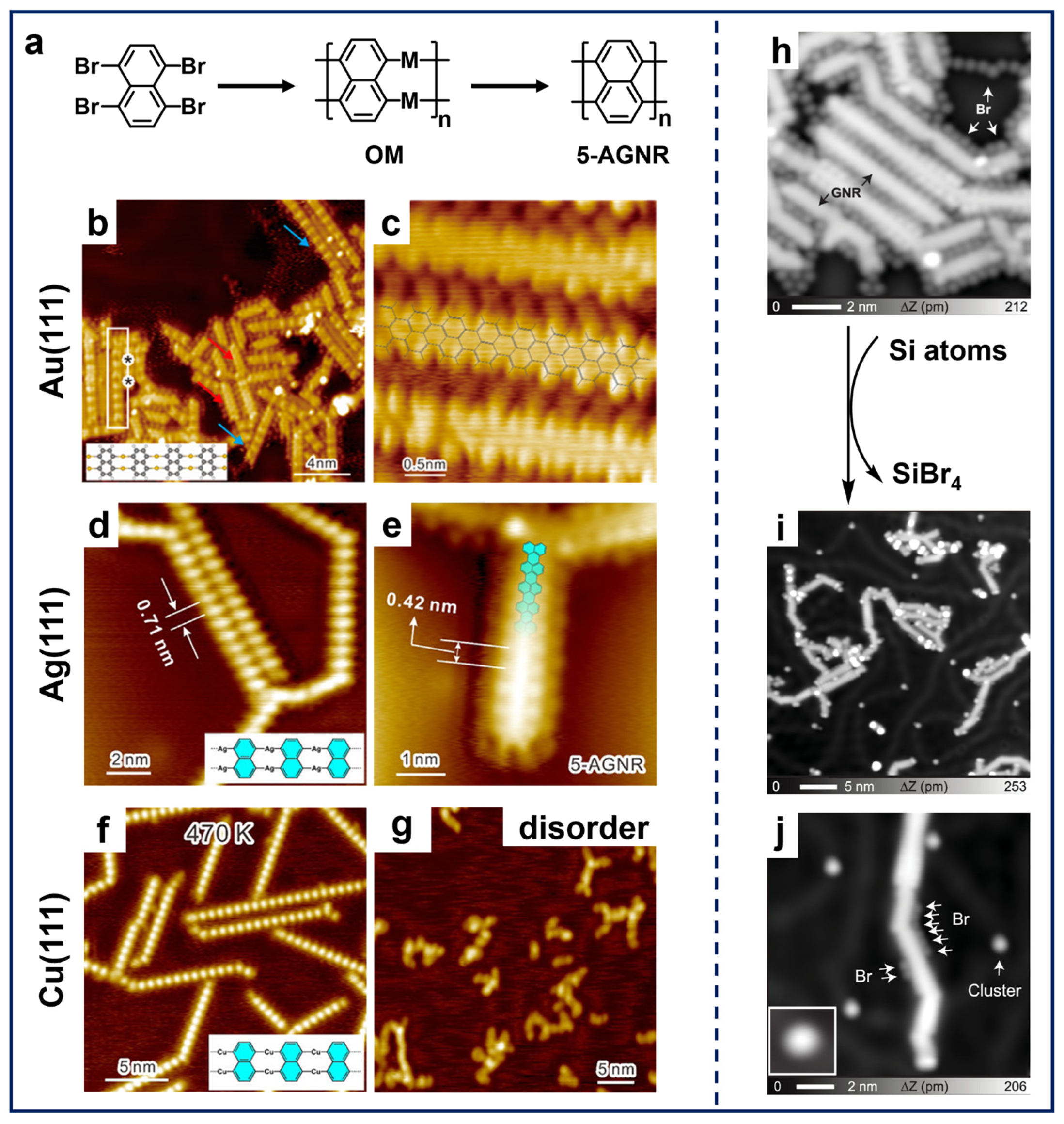
6. Precursors with Bay-Region Substitutions
7. Precursors with Hybrid Substituted Sites
8. Conclusions
Author Contributions
Funding
Conflicts of Interest
References
- Moore, G.E. Progress in digital integrated electronics [Technical literaiture, Copyright 1975 IEEE. Reprinted, with permission. Technical Digest. International Electron Devices Meeting, IEEE, 1975, pp. 11–13.]. IEEE Solid-State Circuits Soc. Newsl. 2006, 11, 36–37. [Google Scholar] [CrossRef]
- Barth, J.V.; Costantini, G.; Kern, K. Engineering atomic and molecular nanostructures at surfaces. Nature 2005, 437, 671–679. [Google Scholar] [CrossRef]
- Wakabayashi, K. Electronic transport properties of nanographite ribbon junctions. Phys. Rev. B 2001, 64, 125428. [Google Scholar] [CrossRef]
- Barone, V.; Hod, O.; Scuseria, G.E. Electronic structure and stability of semiconducting graphene nanoribbons. Nano Lett. 2006, 6, 2748–2754. [Google Scholar] [CrossRef]
- Dinh, C.; Yusufoglu, M.; Yumigeta, K.; Kinikar, A.; Sweepe, T.; Zeszut, Z.; Chang, Y.J.; Copic, C.; Janssen, S.; Holloway, R.; et al. Atomically Precise Graphene Nanoribbon Transistors with Long-Term Stability and Reliability. ACS Nano 2024, 18, 22949–22957. [Google Scholar] [CrossRef] [PubMed]
- Park, Y.; Hamada, I.; Hammud, A.; Kumagai, T.; Wolf, M.; Shiotari, A. Atomic-precision control of plasmon-induced single-molecule switching in a metal-semiconductor nanojunction. Nat. Commun. 2024, 15, 6709. [Google Scholar] [CrossRef] [PubMed]
- Binnig, G.; Rohrer, H.; Gerber, C.; Weibel, E. Tunneling through a Controllable Vacuum Gap. Appl. Phys. Lett. 1982, 40, 178–180. [Google Scholar] [CrossRef]
- Gross, L.; Mohn, F.; Moll, N.; Liljeroth, P.; Meyer, G. The chemical structure of a molecule resolved by atomic force microscopy. Science 2009, 325, 1110–1114. [Google Scholar] [CrossRef]
- Blake, M.M.; Nanayakkara, S.U.; Claridge, S.A.; Fernández -Torres, L.C.; Sykes, E.C.; Weiss, P.S. Identifying reactive intermediates in the Ullmann coupling reaction by scanning tunneling microscopy and spectroscopy. J. Phys. Chem. A 2009, 113, 13167–13172. [Google Scholar] [CrossRef]
- Zhang, C.; Yi, Z.; Xu, W. Scanning probe microscopy in probing low-dimensional carbon-based nanostructures and nanomaterials. Mater. Futures 2022, 1, 032301. [Google Scholar] [CrossRef]
- Zhang, C.; Xu, W. Interactions between water and organic molecules or inorganic salts on surfaces. Aggregate 2022, 3, e175. [Google Scholar] [CrossRef]
- Björk, J.; Hanke, F.; Stafström, S. Mechanisms of Halogen-Based Covalent Self-Assembly on Metal Surfaces. J. Am. Chem. Soc. 2013, 135, 5768–5775. [Google Scholar] [CrossRef]
- Lin, T.; Shang, X.S.; Adisoejoso, J.; Liu, P.N.; Lin, N. Steering On-Surface Polymerization with Metal-Directed Template. J. Am. Chem. Soc. 2013, 135, 3576–3582. [Google Scholar] [CrossRef] [PubMed]
- Xie, L.; Jiang, H.; Li, D.; Liu, M.; Ding, Y.; Liu, Y.; Li, X.; Li, X.; Zhang, H.; Hou, Z.; et al. Selectively Scissoring Hydrogen-Bonded Cytosine Dimer Structures Catalyzed by Water Molecules. ACS Nano 2020, 14, 10680–10687. [Google Scholar] [CrossRef] [PubMed]
- Grill, L.; Dyer, M.; Lafferentz, L.; Persson, M.; Peters, M.V.; Hecht, S. Nano-architectures by covalent assembly of molecular building blocks. Nat. Nanotechnol. 2007, 2, 687–691. [Google Scholar] [CrossRef]
- Clair, S.; de Oteyza, D.G. Controlling a Chemical Coupling Reaction on a Surface: Tools and Strategies for On-Surface Synthesis. Chem. Rev. 2019, 119, 4717–4776. [Google Scholar] [CrossRef]
- Grill, L.; Hecht, S. Covalent on-surface polymerization. Nat. Chem. 2020, 12, 115–130. [Google Scholar] [CrossRef]
- Ullmann, F. Ueber symmetrische Biphenylderivate. Justus Liebigs Ann. Chem. 1904, 332, 38–81. [Google Scholar] [CrossRef]
- Han, D.; Zhu, J. Surface-assisted fabrication of low-dimensional carbon-based nanoarchitectures. J. Phys. Condens. Matter 2021, 33, 343001. [Google Scholar] [CrossRef]
- Lafferentz, L.; Eberhardt, V.; Dri, C.; Africh, C.; Comelli, G.; Esch, F.; Hecht, S.; Grill, L. Controlling on-surface polymerization by hierarchical and substrate-directed growth. Nat. Chem. 2012, 4, 215–220. [Google Scholar] [CrossRef]
- Hla, S.W.; Bartels, L.; Meyer, G.; Rieder, K.-H. Inducing All Steps of a Chemical Reaction with the Scanning Tunneling Microscope Tip: Towards Single Molecule Engineering. Phys. Rev. Lett. 2000, 85, 2777–2780. [Google Scholar] [CrossRef] [PubMed]
- Zhong, Q.; Ihle, A.; Ahles, S.; Wegner, H.A.; Schirmeisen, A.; Ebeling, D. Constructing covalent organic nanoarchitectures molecule by molecule via scanning probe manipulation. Nat. Chem. 2021, 13, 1133–1139. [Google Scholar] [CrossRef]
- Nacci, C.; Schied, M.; Civita, D.; Magnano, E.; Nappini, S.; Píš, I.; Grill, L. Thermal- vs Light-Induced On-Surface Polymerization. J. Phys. Chem. C 2021, 125, 22554–22561. [Google Scholar] [CrossRef]
- Zhang, Z.; Perepichka, D.F.; Khaliullin, R.Z. Adatoms in the Surface-Confined Ullmann Coupling of Phenyl Groups. J. Phys. Chem. Lett. 2021, 12, 11061–11069. [Google Scholar] [CrossRef]
- Wang, W.; Shi, X.; Wang, S.; Van Hove, M.A.; Lin, N. Single-Molecule Resolution of an Organometallic Intermediate in a Surface-Supported Ullmann Coupling Reaction. J. Am. Chem. Soc. 2011, 133, 13264–13267. [Google Scholar] [CrossRef]
- Fan, Q.; Wang, C.; Han, Y.; Zhu, J.; Hieringer, W.; Kuttner, J.; Hilt, G.; Gottfried, J.M. Surface-Assisted Organic Synthesis of Hyperbenzene Nanotroughs. Angew. Chem. Int. Ed. 2013, 52, 4668–4672. [Google Scholar] [CrossRef] [PubMed]
- Zhang, C.; Sun, Q.; Chen, H.; Tan, Q.; Xu, W. Formation of polyphenyl chains through hierarchical reactions: Ullmann coupling followed by cross-dehydrogenative coupling. Chem. Commun. 2015, 51, 495–498. [Google Scholar] [CrossRef] [PubMed]
- Fan, Q.; Wang, T.; Dai, J.; Kuttner, J.; Hilt, G.; Gottfried, J.M.; Zhu, J. On-Surface Pseudo-High-Dilution Synthesis of Macrocycles: Principle and Mechanism. ACS Nano 2017, 11, 5070–5079. [Google Scholar] [CrossRef]
- Lu, H.; E, W.; Cai, L.; Ma, Z.; Xu, W.; Yang, X. Dissymmetric On-Surface Dehalogenation Reaction Steered by Preformed Self-Assembled Structure. J. Phys. Chem. Lett. 2020, 11, 1867–1872. [Google Scholar] [CrossRef]
- Di Giovannantonio, M.; El Garah, M.; Lipton-Duffin, J.; Meunier, V.; Cardenas, L.; Fagot Revurat, Y.; Cossaro, A.; Verdini, A.; Perepichka, D.F.; Rosei, F.; et al. Insight into Organometallic Intermediate and Its Evolution to Covalent Bonding in Surface-Confined Ullmann Polymerization. ACS Nano 2013, 7, 8190–8198. [Google Scholar] [CrossRef]
- Barton, D.; Gao, H.Y.; Held, P.A.; Studer, A.; Fuchs, H.; Doltsinis, N.L.; Neugebauer, J. Formation of Organometallic Intermediate States in On-Surface Ullmann Couplings. Chem.-Eur. J. 2017, 23, 6190–6197. [Google Scholar] [CrossRef] [PubMed]
- Wang, H.; Ma, K.; Chen, X.; Hu, Z.; Sun, Z.; Gao, H.-Y. Metal Atoms Participate in the Self-Assembly and On-Surface Reaction Behaviors of 1,4-DBN on Ag(111) Surface. Chem.-Asian J. 2023, 18, e202300136. [Google Scholar] [CrossRef]
- Lipton-Duffin, J.A.; Ivasenko, O.; Perepichka, D.F.; Rosei, F. Synthesis of Polyphenylene Molecular Wires by Surface-Confined Polymerization. Small 2009, 5, 592–597. [Google Scholar] [CrossRef]
- Zhang, Y.; Ding, Y.; Xie, L.; Ma, H.; Yao, X.; Zhang, C.; Yuan, C.; Xu, W. On-Surface Synthesis of Adenine Oligomers via Ullmann Reaction. ChemPhysChem 2017, 18, 3544–3547. [Google Scholar] [CrossRef]
- Zhu, X.; Liu, Y.; Pu, W.; Liu, F.-Z.; Xue, Z.; Sun, Z.; Yan, K.; Yu, P. On-Surface Synthesis of C144 Hexagonal Coronoid with Zigzag Edges. ACS Nano 2022, 16, 10600–10607. [Google Scholar] [CrossRef]
- Sánchez-Sánchez, C.; Nicolaï, A.; Rossel, F.; Cai, J.; Liu, J.; Feng, X.; Müllen, K.; Ruffieux, P.; Fasel, R.; Meunier, V. On-Surface Cyclization of ortho-Dihalotetracenes to Four- and Six-Membered Rings. J. Am. Chem. Soc. 2017, 139, 17617–17623. [Google Scholar] [CrossRef] [PubMed]
- Tran, B.V.; Pham, T.A.; Grunst, M.; Kivala, M.; Stöhr, M. Surface-confined [2 + 2] cycloaddition towards one-dimensional polymers featuring cyclobutadiene units. Nanoscale 2017, 9, 18305–18310. [Google Scholar] [CrossRef] [PubMed]
- Zhang, R.; Xia, B.; Xu, H.; Lin, N. Identifying Multinuclear Organometallic Intermediates in On-Surface [2+2] Cycloaddition Reactions. Angew. Chem. Int. Ed. 2019, 58, 16485–16489. [Google Scholar] [CrossRef]
- Zhang, C.; Kazuma, E.; Kim, Y. Atomic-Scale Visualization of the Stepwise Metal-Mediated Dehalogenative Cycloaddition Reaction Pathways: Competition between Radicals and Organometallic Intermediates. Angew. Chem. Int. Ed. 2019, 58, 17736–17744. [Google Scholar] [CrossRef]
- Li, D.-Y.; Qiu, X.; Li, S.-W.; Ren, Y.-T.; Zhu, Y.-C.; Shu, C.-H.; Hou, X.-Y.; Liu, M.; Shi, X.-Q.; Qiu, X.; et al. Ladder Phenylenes Synthesized on Au(111) Surface via Selective [2+2] Cycloaddition. J. Am. Chem. Soc. 2021, 143, 12955–12960. [Google Scholar] [CrossRef]
- Zhang, H.; Lin, H.; Sun, K.; Chen, L.; Zagranyarski, Y.; Aghdassi, N.; Duhm, S.; Li, Q.; Zhong, D.; Li, Y.; et al. On-Surface Synthesis of Rylene-Type Graphene Nanoribbons. J. Am. Chem. Soc. 2015, 137, 4022–4025. [Google Scholar] [CrossRef] [PubMed]
- Zhang, T.; Li, R.; Hao, X.; Zhang, Q.; Yang, H.; Hou, Y.; Hou, B.; Jia, L.; Jiang, K.; Zhang, Y.; et al. Ullmann-Like Covalent Bond Coupling without Participation of Metal Atoms. ACS Nano 2023, 17, 4387–4395. [Google Scholar] [CrossRef]
- Zhang, H.; Franke, J.H.; Zhong, D.; Li, Y.; Timmer, A.; Arado, O.D.; Mönig, H.; Wang, H.; Chi, L.; Wang, Z.; et al. Surface Supported Gold–Organic Hybrids: On-Surface Synthesis and Surface Directed Orientation. Small 2014, 10, 1361–1368. [Google Scholar] [CrossRef]
- Kawai, S.; Takahashi, K.; Ito, S.; Pawlak, R.; Meier, T.; Spijker, P.; Canova, F.F.; Tracey, J.; Nozaki, K.; Foster, A.S.; et al. Competing Annulene and Radialene Structures in a Single Anti-Aromatic Molecule Studied by High-Resolution Atomic Force Microscopy. ACS Nano 2017, 11, 8122–8130. [Google Scholar] [CrossRef]
- Zhong, Q.; Hu, Y.; Niu, K.; Zhang, H.; Yang, B.; Ebeling, D.; Tschakert, J.; Cheng, T.; Schirmeisen, A.; Narita, A.; et al. Benzo-Fused Periacenes or Double Helicenes? Different Cyclodehydrogenation Pathways on Surface and in Solution. J. Am. Chem. Soc. 2019, 141, 7399–7406. [Google Scholar] [CrossRef] [PubMed]
- Feng, L.; Wang, T.; Jia, H.; Huang, J.; Han, D.; Zhang, W.; Ding, H.; Xu, Q.; Du, P.; Zhu, J. On-surface synthesis of planar acenes via regioselective aryl-aryl coupling. Chem. Commun. 2020, 56, 4890–4893. [Google Scholar] [CrossRef]
- Song, S.; Wang, L.; Su, J.; Xu, Z.; Hsu, C.-H.; Hua, C.; Lyu, P.; Li, J.; Peng, X.; Kojima, T.; et al. Manifold dynamic non-covalent interactions for steering molecular assembly and cyclization. Chem. Sci. 2021, 12, 11659–11667. [Google Scholar] [CrossRef] [PubMed]
- Zeng, Z.; Guo, D.; Wang, T.; Chen, Q.; Matěj, A.; Huang, J.; Han, D.; Xu, Q.; Zhao, A.; Jelínek, P.; et al. Chemisorption-Induced Formation of Biphenylene Dimer on Ag(111). J. Am. Chem. Soc. 2022, 144, 723–732. [Google Scholar] [CrossRef] [PubMed]
- Gao, Y.; Zhang, Z.; Yi, Z.; Zhang, C.; Xu, W. Visualizing the Hierarchical Evolution of Aryl-Metal Bonding in Organometallic Nanostructures on Ag(111). J. Phys. Chem. Lett. 2023, 14, 10819–10824. [Google Scholar] [CrossRef]
- Zhang, H.; Chi, L. Gold-Organic Hybrids: On-Surface Synthesis and Perspectives. Adv. Mater. 2016, 28, 10492–10498. [Google Scholar] [CrossRef]
- Di Giovannantonio, M.; Tomellini, M.; Lipton-Duffin, J.; Galeotti, G.; Ebrahimi, M.; Cossaro, A.; Verdini, A.; Kharche, N.; Meunier, V.; Vasseur, G.; et al. Mechanistic Picture and Kinetic Analysis of Surface-Confined Ullmann Polymerization. J. Am. Chem. Soc. 2016, 138, 16696–16702. [Google Scholar] [CrossRef] [PubMed]
- Vasseur, G.; Fagot-Revurat, Y.; Sicot, M.; Kierren, B.; Moreau, L.; Malterre, D.; Cardenas, L.; Galeotti, G.; Lipton-Duffin, J.; Rosei, F.; et al. Quasi one-dimensional band dispersion and surface metallization in long-range ordered polymeric wires. Nat. Commun. 2016, 7, 10235. [Google Scholar] [CrossRef] [PubMed]
- Cheng, S.; Su, X.; Gan, F.; Shen, C.; Qiu, H.; Tao, K.; Yu, P. Stepwise On-Surface Synthesis of Porous Carbon Nanoribbons with Notched Zigzag Edges. J. Phys. Chem. C 2020, 124, 756–763. [Google Scholar] [CrossRef]
- Wang, C.-X.; Chen, J.-L.; Shu, C.-H.; Shi, K.-J.; Liu, P.-N. On-surface synthesis of 2D COFs on Cu(111) via the formation of thermodynamically stable organometallic networks as the template. Phys. Chem. Chem. Phys. 2019, 21, 13222–13229. [Google Scholar] [CrossRef]
- Sadowsky, D.; McNeill, K.; Cramer, C.J. Thermochemical Factors Affecting the Dehalogenation of Aromatics. Environ. Sci. Technol. 2013, 47, 14194–14203. [Google Scholar] [CrossRef] [PubMed]
- Galeotti, G.; Di Giovannantonio, M.; Lipton-Duffin, J.; Ebrahimi, M.; Tebi, S.; Verdini, A.; Floreano, L.; Fagot-Revurat, Y.; Perepichka, D.F.; Rosei, F.; et al. The role of halogens in on-surface Ullmann polymerization. Faraday Discuss. 2017, 204, 453–469. [Google Scholar] [CrossRef]
- Qin, T.; Liang, B.; Hu, L.; Xu, Q.; Wang, T.; Zhu, J. On-Surface Synthesis of Two-Dimensional Carbon-Based Networks via Hierarchical Ullmann Coupling Reactions. ChemPhysChem 2025, 26, e202400601. [Google Scholar] [CrossRef]
- Shu, C.-H.; Kang, L.-X.; Wang, S.-s.; He, Y.; Zhang, R.-X.; Su, X.; Yu, P.; Li, X.; Liu, P.-N. Hierarchical On-Surface Synthesis of Two-Dimensional Networks via Multipoint S···N and S···H Bonding. CCS Chem. 2025, 7, 170–179. [Google Scholar] [CrossRef]
- Galeotti, G.; Di Giovannantonio, M.; Cupo, A.; Xing, S.; Lipton-Duffin, J.; Ebrahimi, M.; Vasseur, G.; Kierren, B.; Fagot-Revurat, Y.; Tristant, D.; et al. An unexpected organometallic intermediate in surface-confined Ullmann coupling. Nanoscale 2019, 11, 7682–7689. [Google Scholar] [CrossRef]
- Abyazisani, M.; MacLeod, J.M.; Lipton-Duffin, J. Cleaning up after the Party: Removing the Byproducts of On-Surface Ullmann Coupling. ACS Nano 2019, 13, 9270–9278. [Google Scholar] [CrossRef]
- Rastgoo Lahrood, A.; Björk, J.; Heckl, W.M.; Lackinger, M. 1,3-Diiodobenzene on Cu(111)—An exceptional case of on-surface Ullmann coupling. Chem. Commun. 2015, 51, 13301–13304. [Google Scholar] [CrossRef]
- Fan, Q.; Wang, C.; Liu, L.; Han, Y.; Zhao, J.; Zhu, J.; Kuttner, J.; Hilt, G.; Gottfried, J.M. Covalent, Organometallic, and Halogen-Bonded Nanomeshes from Tetrabromo-Terphenyl by Surface-Assisted Synthesis on Cu(111). J. Phys. Chem. C 2014, 118, 13018–13025. [Google Scholar] [CrossRef]
- Pham, T.A.; Song, F.; Nguyen, M.-T.; Li, Z.; Studener, F.; Stöhr, M. Comparing Ullmann Coupling on Noble Metal Surfaces: On-Surface Polymerization of 1,3,6,8-Tetrabromopyrene on Cu(111) and Au(111). Chem.-Eur. J. 2016, 22, 5937–5944. [Google Scholar] [CrossRef] [PubMed]
- Shingae, S.; Sakaue, H.; Tominari, Y.; Yamada, T.; Tanaka, S.; Suzuki, H. Structures formed by tetrabromobiphenyl molecules with adapted orientations on the Au(111) surface. Chem. Phys. Lett. 2024, 849, 141417. [Google Scholar] [CrossRef]
- Peyrot, D.; Silly, M.G.; Silly, F. Temperature-Triggered Sequential On-Surface Synthesis of One and Two Covalently Bonded Porous Organic Nanoarchitectures on Au(111). J. Phys. Chem. C 2017, 121, 26815–26821. [Google Scholar] [CrossRef]
- Fan, Q.; Wang, T.; Liu, L.; Zhao, J.; Zhu, J.; Gottfried, J.M. Tribromobenzene on Cu(111): Temperature-dependent formation of halogen-bonded, organometallic, and covalent nanostructures. J. Chem. Phys. 2015, 142, 101906. [Google Scholar] [CrossRef]
- Lischka, M.; Fritton, M.; Eichhorn, J.; Vyas, V.S.; Strunskus, T.; Lotsch, B.V.; Björk, J.; Heckl, W.M.; Lackinger, M. On-Surface Polymerization of 1,6-Dibromo-3,8-diiodpyrene—A Comparative Study on Au(111) Versus Ag(111) by STM, XPS, and NEXAFS. J. Phys. Chem. C 2018, 122, 5967–5977. [Google Scholar] [CrossRef]
- Sun, K.; Krejči, O.; Foster, A.S.; Okuda, Y.; Orita, A.; Kawai, S. Synthesis of Regioisomeric Graphene Nanoribbon Junctions via Heteroprecursors. J. Phys. Chem. C 2019, 123, 17632–17638. [Google Scholar] [CrossRef]
- Hou, I.C.-Y.; Sun, Q.; Eimre, K.; Di Giovannantonio, M.; Urgel, J.I.; Ruffieux, P.; Narita, A.; Fasel, R.; Müllen, K. On-Surface Synthesis of Unsaturated Carbon Nanostructures with Regularly Fused Pentagon—Heptagon Pairs. J. Am. Chem. Soc. 2020, 142, 10291–10296. [Google Scholar] [CrossRef]
- Fan, Q.; Werner, S.; Tschakert, J.; Ebeling, D.; Schirmeisen, A.; Hilt, G.; Hieringer, W.; Gottfried, J.M. Precise Monoselective Aromatic C–H Bond Activation by Chemisorption of Meta-Aryne on a Metal Surface. J. Am. Chem. Soc. 2018, 140, 7526–7532. [Google Scholar] [CrossRef]
- Cai, J.; Ruffieux, P.; Jaafar, R.; Bieri, M.; Braun, T.; Blankenburg, S.; Muoth, M.; Seitsonen, A.P.; Saleh, M.; Feng, X.; et al. Atomically precise bottom-up fabrication of graphene nanoribbons. Nature 2010, 466, 470–473. [Google Scholar] [CrossRef] [PubMed]
- de Oteyza, D.G.; García-Lekue, A.; Vilas-Varela, M.; Merino-Díez, N.; Carbonell-Sanromà, E.; Corso, M.; Vasseur, G.; Rogero, C.; Guitián, E.; Pascual, J.I.; et al. Substrate-Independent Growth of Atomically Precise Chiral Graphene Nanoribbons. ACS Nano 2016, 10, 9000–9008. [Google Scholar] [CrossRef]
- Fan, Q.; Martin-Jimenez, D.; Werner, S.; Ebeling, D.; Koehler, T.; Vollgraff, T.; Sundermeyer, J.; Hieringer, W.; Schirmeisen, A.; Gottfried, J.M. On-Surface Synthesis and Characterization of a Cycloarene: C108 Graphene Ring. J. Am. Chem. Soc. 2020, 142, 894–899. [Google Scholar] [CrossRef] [PubMed]
- Yamada, T.K.; Nemoto, R.; Ishii, H.; Nishino, F.; Chang, Y.-H.; Wang, C.-H.; Krüger, P.; Horie, M. Designing 2D stripe winding network through crown-ether intermediate Ullmann coupling on Cu(111) surface. Nanoscale Horiz. 2024, 9, 718–730. [Google Scholar] [CrossRef] [PubMed]
- Sánchez-Sánchez, C.; Dienel, T.; Nicolaï, A.; Kharche, N.; Liang, L.; Daniels, C.; Meunier, V.; Liu, J.; Feng, X.; Müllen, K.; et al. On-Surface Synthesis and Characterization of Acene-Based Nanoribbons Incorporating Four-Membered Rings. Chem.-Eur. J. 2019, 25, 12074–12082. [Google Scholar] [CrossRef]
- Wang, J.; Deng, C.; Zhang, Y.; Niu, K.; Zhao, X.; Zhu, H.; Zhang, Y.; Huang, P.; Lin, H.; Lu, J.; et al. Mechanistical Study on Substrate-Controlled Highly Selective [2+2] and [2+3] Cycloaddition Reactions. Chem.-Eur. J. 2025, 31, e202404074. [Google Scholar] [CrossRef]
- Huang, Y.L.; Yang, K.; Yang, J.; Duan, S.; Wang, Y.; Sun, M.; Zhang, Y.-W.; Yang, M.; Wee, A.T.S. Redirecting On-surface Cycloaddition Reactions in a Self-assembled Ordered Molecular Array on Graphite. Angew. Chem. Int. Ed. 2025, 64, e202425185. [Google Scholar] [CrossRef]
- Zhang, R.; Xia, B.; Xu, H.; Lin, N. Kinetically Controlled Synthesis of Four- and Six-Member Cyclic Products via Sequential Aryl-Aryl Coupling on a Au(111) Surface. ChemPhysChem 2019, 20, 2292–2296. [Google Scholar] [CrossRef]
- Li, J.; Martin, K.; Avarvari, N.; Wäckerlin, C.; Ernst, K.H. Spontaneous separation of on-surface synthesized tris-helicenes into two-dimensional homochiral domains. Chem. Commun. 2018, 54, 7948–7951. [Google Scholar] [CrossRef]
- Liu, J.; Xia, B.; Xu, H.; Lin, N. Controlling the Reaction Steps of Bifunctional Molecules 1,5-Dibromo-2,6-dimethylnaphthalene on Different Substrates. J. Phys. Chem. C 2018, 122, 13001–13008. [Google Scholar] [CrossRef]
- Mohammed, M.S.G.; Lawrence, J.; García, F.; Brandimarte, P.; Berdonces-Layunta, A.; Pérez, D.; Sánchez-Portal, D.; Peña, D.; de Oteyza, D.G. From starphenes to non-benzenoid linear conjugated polymers by substrate templating. Nanoscale Adv. 2021, 3, 2351–2358. [Google Scholar] [CrossRef] [PubMed]
- Koch, M.; Gille, M.; Hecht, S.; Grill, L. Steering a cycloaddition reaction via the surface structure. Surf. Sci. 2018, 678, 194–200. [Google Scholar] [CrossRef]
- Xi, J.; Xue, R.; Li, X.; Lin, Y.; Peng, G.; Wang, J.; You, S.; Xu, C.; Zhang, H.; Chi, L. Highly Selective On-Surface [2 + 2] Cycloaddition Induced by Hierarchical Metal–Organic Hybrids. J. Phys. Chem. Lett. 2023, 14, 1585–1591. [Google Scholar] [CrossRef]
- Wang, S.; Nishiuchi, T.; Pignedoli, C.A.; Yao, X.; Di Giovannantonio, M.; Zhao, Y.; Narita, A.; Feng, X.; Müllen, K.; Ruffieux, P.; et al. Steering on-surface reactions through molecular steric hindrance and molecule-substrate van der Waals interactions. Quantum Front. 2022, 1, 23. [Google Scholar] [CrossRef]
- Zhang, H.; Lu, J.; Li, B.; Zhao, X.J.; Zhou, H.; Niu, G.; Xiong, W.; Zhang, Y.; Fu, B.; Gao, L.; et al. On-Surface Synthesis of Chiral Graphene Nanoribbon Segments via the Quarter-Anthryl on Au(111) Surface. Adv. Mater. Interfaces 2023, 10, 2201949. [Google Scholar] [CrossRef]
- Gao, P.-H.; Chen, C.; Wang, X.-Y. Heteroatom-Doped Graphene Nanoribbons: Precision Synthesis and Emerging Properties. Chin. J. Chem. 2024, 42, 2877–2894. [Google Scholar] [CrossRef]
- Fan, Q.; Ruan, Z.; Werner, S.; Naumann, T.; Bolat, R.; Martinez-Castro, J.; Koehler, T.; Vollgraff, T.; Hieringer, W.; Mandalia, R.; et al. Bottom-up Synthesis and Characterization of Porous 12-Atom-Wide Armchair Graphene Nanoribbons. Nano Lett. 2024, 24, 10718–10723. [Google Scholar] [CrossRef]
- Xu, X.; Kinikar, A.; Di Giovannantonio, M.; Pignedoli, C.A.; Ruffieux, P.; Müllen, K.; Fasel, R.; Narita, A. On-Surface Synthesis of Anthracene-Fused Zigzag Graphene Nanoribbons from 2,7-Dibromo-9,9’-bianthryl Reveals Unexpected Ring Rearrangements. Precis. Chem. 2024, 2, 81–87. [Google Scholar] [CrossRef]
- Sun, K.; Li, X.; Chen, L.; Zhang, H.; Chi, L. Substrate-Controlled Synthesis of 5-Armchair Graphene Nanoribbons. J. Phys. Chem. C 2020, 124, 11422–11427. [Google Scholar] [CrossRef]
- Fritton, M.; Duncan, D.A.; Deimel, P.S.; Rastgoo-Lahrood, A.; Allegretti, F.; Barth, J.V.; Heckl, W.M.; Björk, J.; Lackinger, M. The Role of Kinetics versus Thermodynamics in Surface-Assisted Ullmann Coupling on Gold and Silver Surfaces. J. Am. Chem. Soc. 2019, 141, 4824–4832. [Google Scholar] [CrossRef]
- Zuzak, R.; Jančařík, A.; Gourdon, A.; Szymonski, M.; Godlewski, S. On-Surface Synthesis with Atomic Hydrogen. ACS Nano 2020, 14, 13316–13323. [Google Scholar] [CrossRef] [PubMed]
- Enderson, Z.A.; Murali, H.; Dasari, R.R.; Dai, Q.; Li, H.; Parker, T.C.; Brédas, J.-L.; Marder, S.R.; First, P.N. Tailoring On-Surface Molecular Reactions and Assembly through Hydrogen-Modified Synthesis: From Triarylamine Monomer to 2D Covalent Organic Framework. ACS Nano 2023, 17, 7366–7376. [Google Scholar] [CrossRef] [PubMed]
- Sun, K.; Nishiuchi, T.; Sahara, K.; Kubo, T.; Foster, A.S.; Kawai, S. Low-Temperature Removal of Dissociated Bromine by Silicon Atoms for an On-Surface Ullmann Reaction. J. Phys. Chem. C 2020, 124, 19675–19680. [Google Scholar] [CrossRef]
- Zhang, Z.; Gao, Y.; Yi, Z.; Zhang, C.; Xu, W. Separation of Halogen Atoms by Sodium from Dehalogenative Reactions on a Au(111) Surface. ACS Nano 2024, 18, 9082–9091. [Google Scholar] [CrossRef]
- Carrell, C.J.; Carrell, H.L.; Glusker, J.P.; Abu-Shaqara, E.; Cortez, C.; Harvey, R.G. Bay- and fjord-region distortions in dibenz[a,j]anthracene and tetrabenzo[de,hi,mn,qr]naphthacene. Carcinogenesis 1994, 15, 2931–2936. [Google Scholar] [CrossRef]
- Liu, M.; Liu, M.; She, L.; Zha, Z.; Pan, J.; Li, S.; Li, T.; He, Y.; Cai, Z.; Wang, J.; et al. Graphene-like nanoribbons periodically embedded with four- and eight-membered rings. Nat. Commun. 2017, 8, 14924. [Google Scholar] [CrossRef]
- Izydorczyk, I.; Stoica, O.; Krawiec, M.; Blieck, R.; Zuzak, R.; Stępień, M.; Echavarren, A.M.; Godlewski, S. On-surface synthesis of a phenylene analogue of nonacene. Chem. Commun. 2022, 58, 4063–4066. [Google Scholar] [CrossRef]
- Schunke, C.; Schweer, P.; Engelage, E.; Austin, D.; Switzer, E.D.; Rahman, T.S.; Morgenstern, K. Increased Selectivity in Photolytic Activation of Nanoassemblies Compared to Thermal Activation in On-Surface Ullmann Coupling. ACS Nano 2024, 18, 11665–11674. [Google Scholar] [CrossRef] [PubMed]
- Shang, L.; Gao, W.; Kang, F.; Zhang, Z.; Zhang, C.; Xu, W. Real-space visualization of sequential debromination of polybrominated benzenes on Ag(111). Chem. Commun. 2023, 59, 704–707. [Google Scholar] [CrossRef]
- Zuzak, R.; Brandimarte, P.; Olszowski, P.; Izydorczyk, I.; Markoulides, M.; Such, B.; Kolmer, M.; Szymonski, M.; Garcia-Lekue, A.; Sánchez-Portal, D.; et al. On-Surface Synthesis of Chlorinated Narrow Graphene Nanoribbon Organometallic Hybrids. J. Phys. Chem. Lett. 2020, 11, 10290–10297. [Google Scholar] [CrossRef]
- Zhong, Q.; Niu, K.; Chen, L.; Zhang, H.; Ebeling, D.; Björk, J.; Müllen, K.; Schirmeisen, A.; Chi, L. Substrate-Modulated Synthesis of Metal-Organic Hybrids by Tunable Multiple Aryl-Metal Bonds. J. Am. Chem. Soc. 2022, 144, 8214–8222. [Google Scholar] [CrossRef] [PubMed]
- Zhang, C.; Hou, R.; Xu, W. Surface Organic Nanostructures Mediated by Extrinsic Components: From Assembly to Reaction. Small Methods 2025, e2402118. [Google Scholar] [CrossRef] [PubMed]
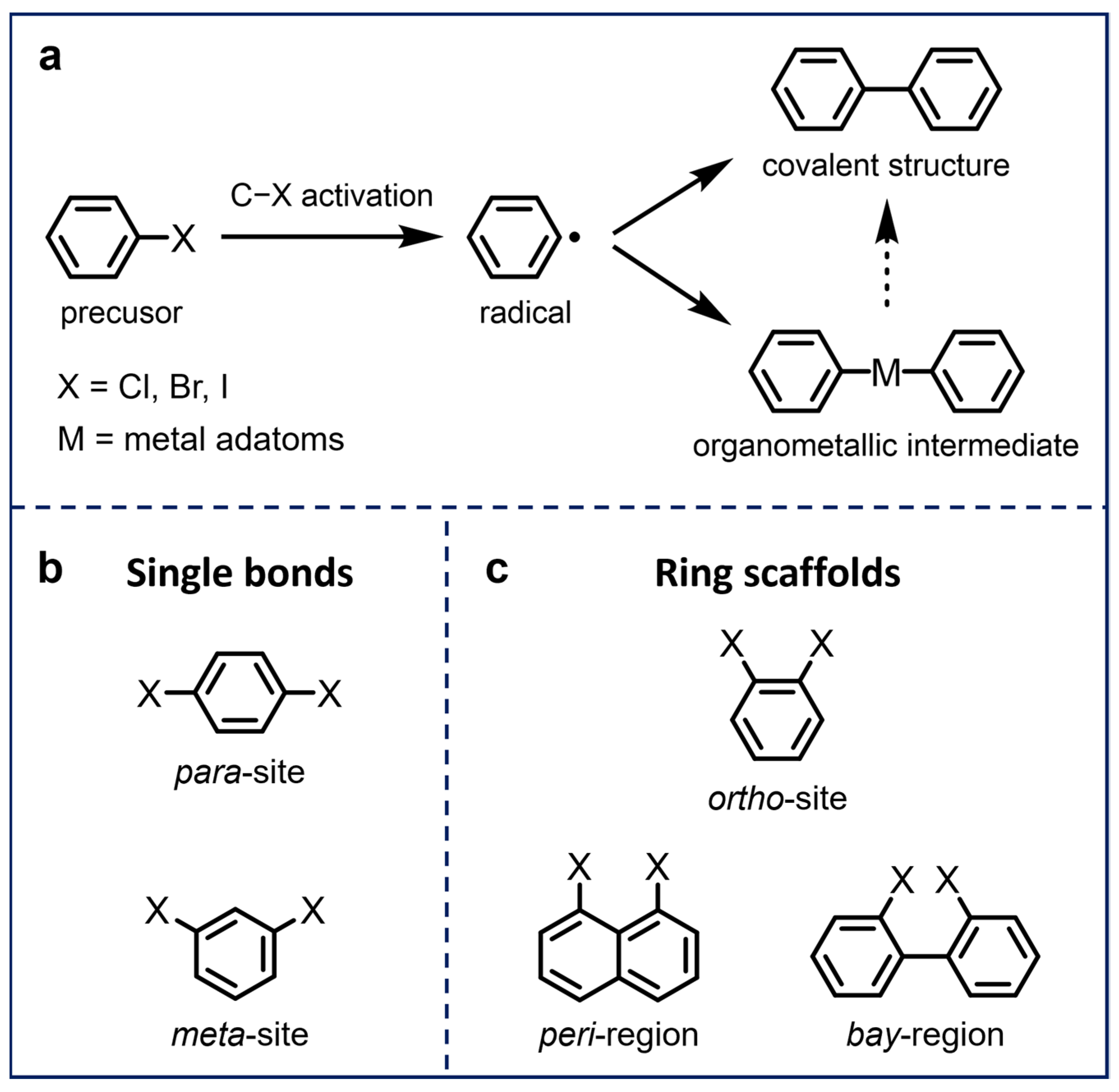

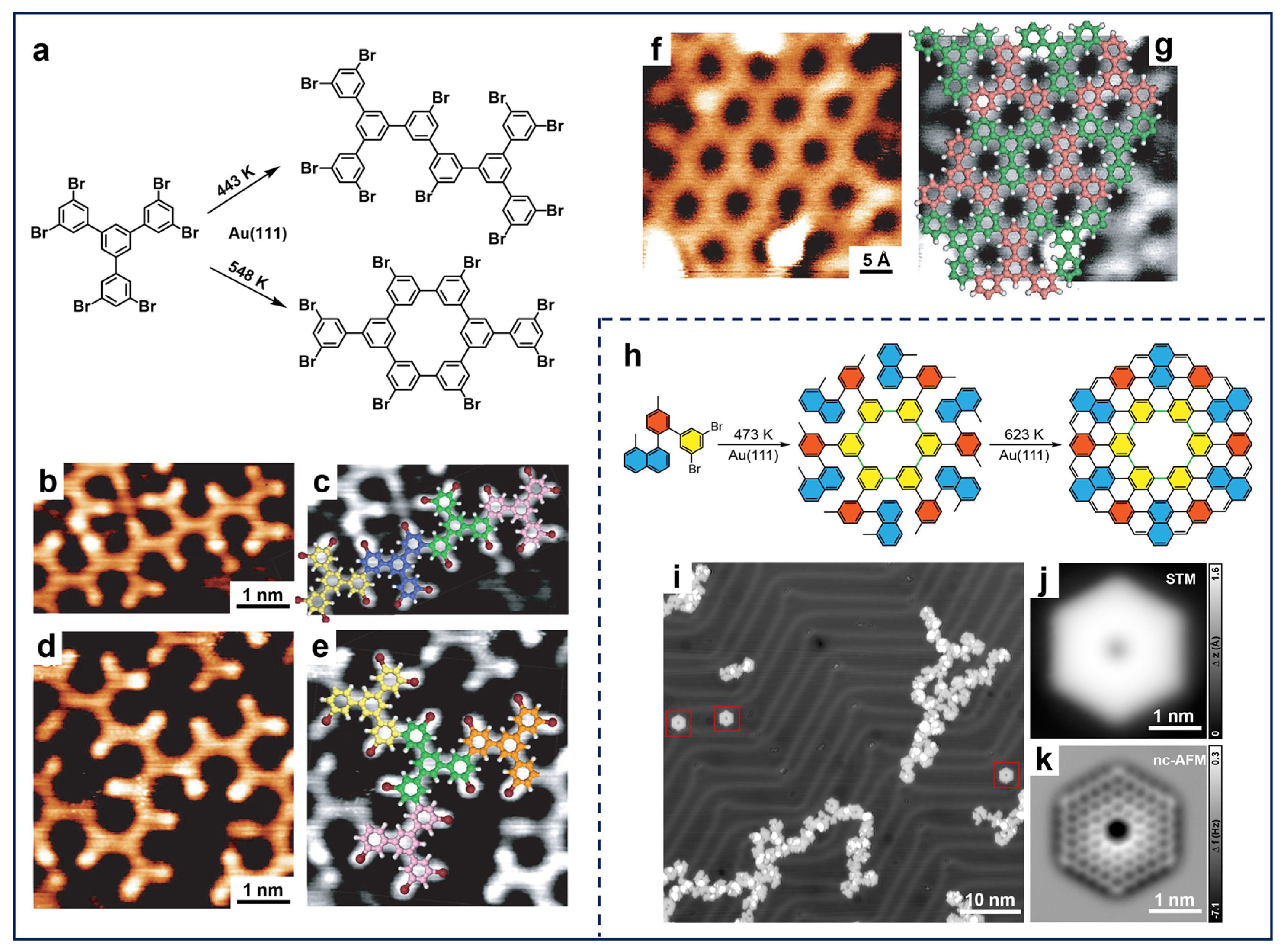
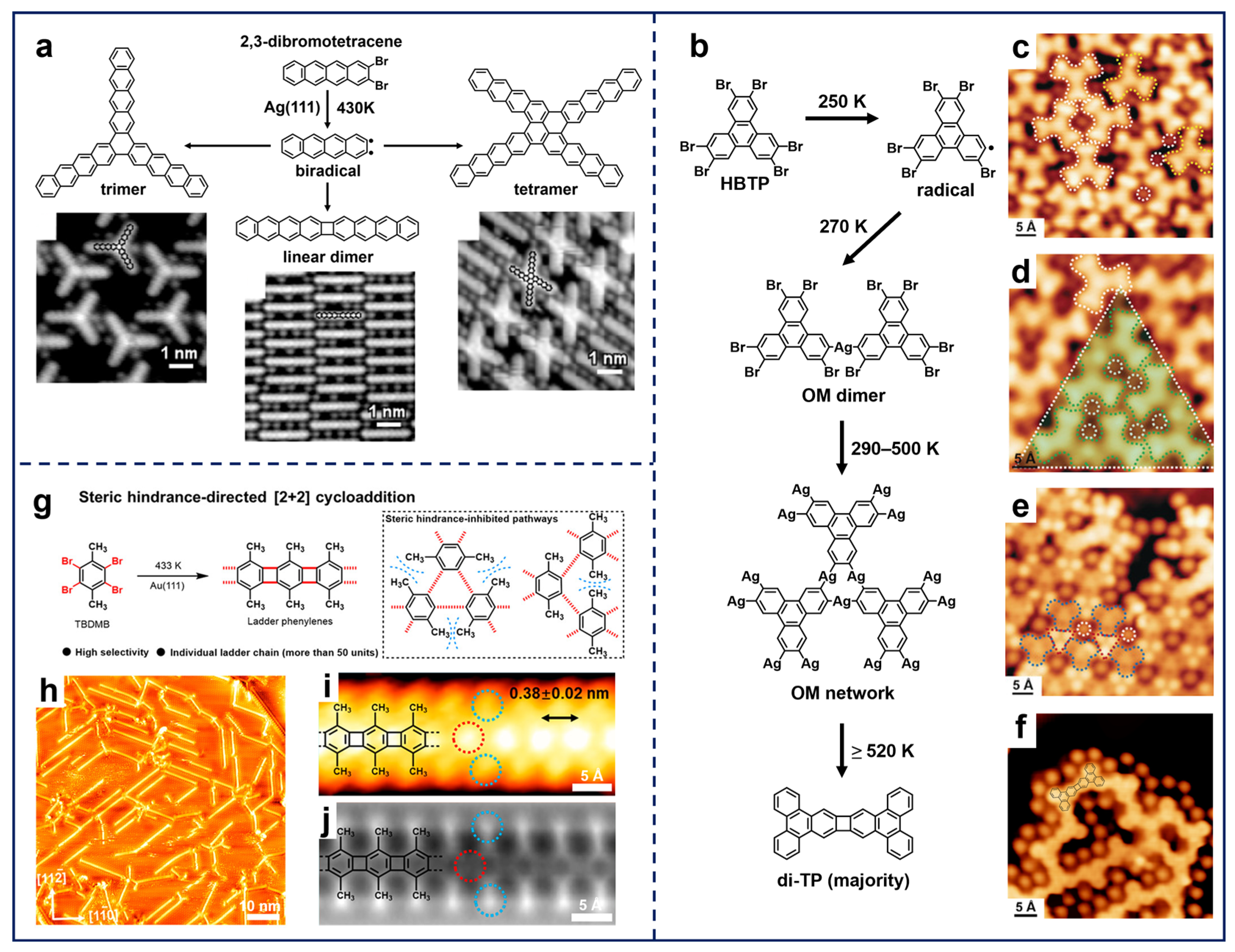


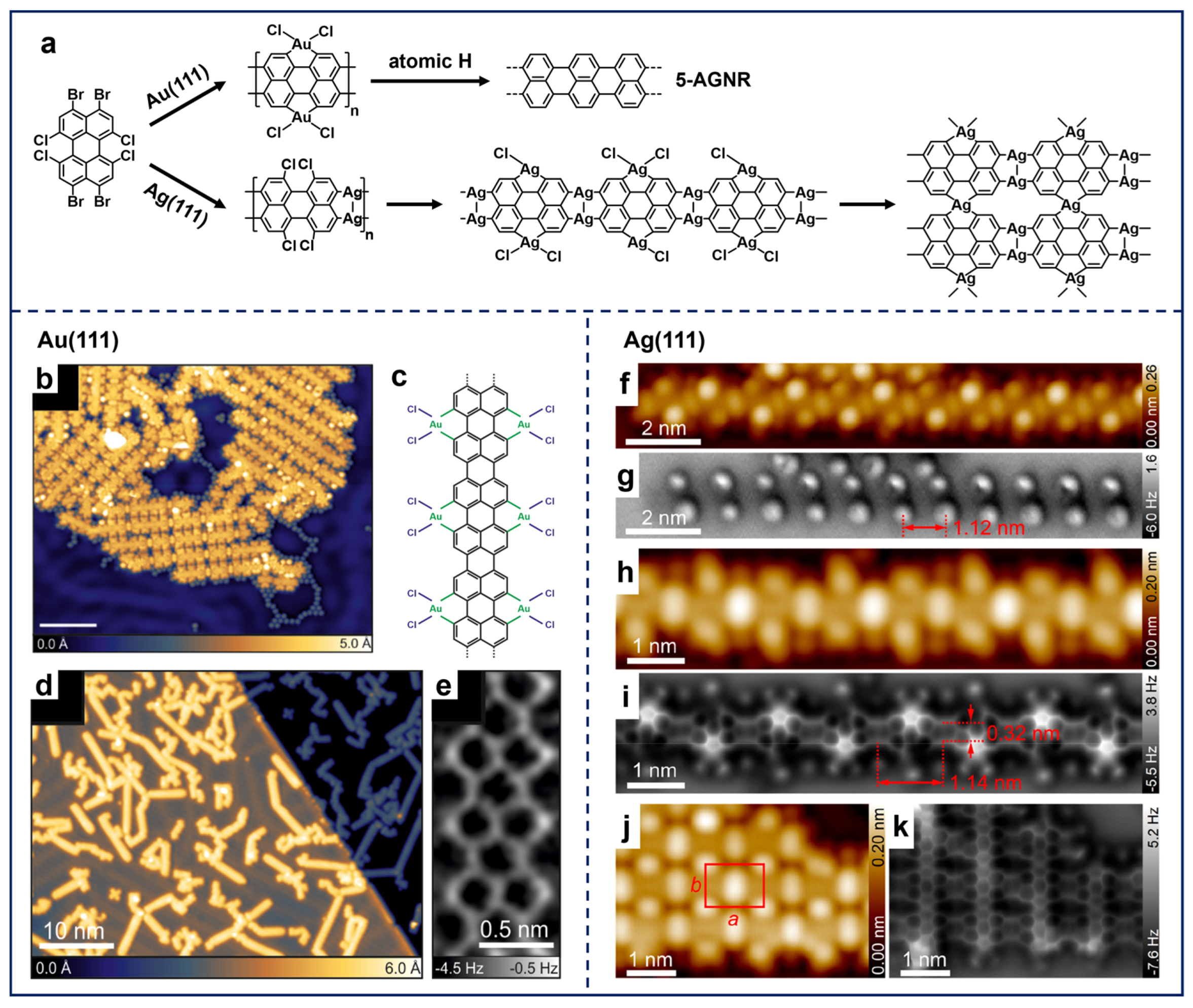
Disclaimer/Publisher’s Note: The statements, opinions and data contained in all publications are solely those of the individual author(s) and contributor(s) and not of MDPI and/or the editor(s). MDPI and/or the editor(s) disclaim responsibility for any injury to people or property resulting from any ideas, methods, instructions or products referred to in the content. |
© 2025 by the authors. Licensee MDPI, Basel, Switzerland. This article is an open access article distributed under the terms and conditions of the Creative Commons Attribution (CC BY) license (https://creativecommons.org/licenses/by/4.0/).
Share and Cite
Liu, Q.; Gao, Y.; Zhang, C. On-Surface Ullmann-Type Coupling Reactions of Aryl Halide Precursors with Multiple Substituted Sites. Nanomaterials 2025, 15, 646. https://doi.org/10.3390/nano15090646
Liu Q, Gao Y, Zhang C. On-Surface Ullmann-Type Coupling Reactions of Aryl Halide Precursors with Multiple Substituted Sites. Nanomaterials. 2025; 15(9):646. https://doi.org/10.3390/nano15090646
Chicago/Turabian StyleLiu, Qiwei, Yuhong Gao, and Chi Zhang. 2025. "On-Surface Ullmann-Type Coupling Reactions of Aryl Halide Precursors with Multiple Substituted Sites" Nanomaterials 15, no. 9: 646. https://doi.org/10.3390/nano15090646
APA StyleLiu, Q., Gao, Y., & Zhang, C. (2025). On-Surface Ullmann-Type Coupling Reactions of Aryl Halide Precursors with Multiple Substituted Sites. Nanomaterials, 15(9), 646. https://doi.org/10.3390/nano15090646






